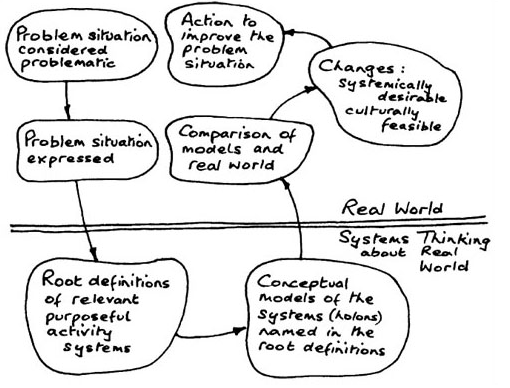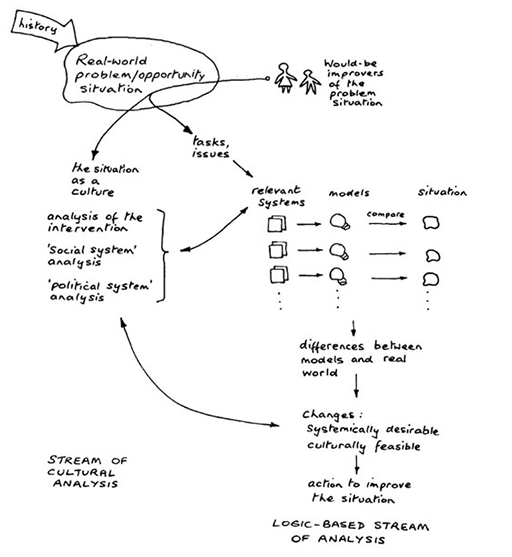6 Soft systems methodology
SSM is one of the more widely used systems methods. The driving force behind its development and increasing application across many domains, but particularly information systems, has been Peter Checkland at The University of Lancaster in the UK (Checkland, 1993). You heard Peter Checkland talk about the reasons for developing SSM in Week 6 which I will not repeat here, but I will mention some of the underlying ideas which permeate soft system thinking in general, ideas that you have already encountered in this course.
First, soft system thinking does not assume that problems are out there in the world in a real sense. Working from a soft perspective there are no objectively given problems. This does not mean that the world is not full of difficult and complex issues which need to be managed but it is important to realise that different people may see different problems in the same situation and come to different conclusions as to their nature. It is, perhaps, misleading to talk of the context as though it were objectively agreed upon and accepted by all parties and stakeholders. Rather it is more appropriate with soft systems thinking to describe those involved in messy contexts as problem owners – this makes a clear relationship between the context and those who are experiencing it. A context is the combination of the external world together with the way it seems to the observers or participants, some of whom may not even see any problem at all in the given context.
Second, soft systems thinking assumes that problems are much less structured, and much messier than some users and advocates of reductionist science would accept. Indeed a key feature of many situations is that they are unbounded, unclear and uncertain and that the observer may be unsure if there is a ‘problem’ except for those within the situation believing something is ‘not right’. This is why the term ‘problem context’ or ‘problem situation’ – rather than just ‘problem’ – is used to describe what confronts that analyst.
A third consideration to keep in mind is that just as problem definition is a construct of our own creation, so are ‘solutions’. A group of people may agree on the nature of a given problem, yet disagree (violently in some cases) as to what constitutes a solution. The aim is to move from the present state of affairs to a desired state of affairs when no one has a map to work from.
Fourth, it is important that the situation is investigated and analysed before any decision on the desirability of a specific form of solution or medial activity is taken. In this sense the role of the systems analyst (the title usually ascribed to the person attempting to understand the nature of a systemic problem) can be viewed, at least initially, as much more akin to a therapist than a technical expert. The analyst encourages participants or stakeholders in the exiting context to examine their own perceptions of the context and its interconnections with others. Such a review will include an analysis of objectives, the role of the client within the context and the role of other stakeholders. SSM is concerned with what is meant by a problem and what action (new or pre-planned) would mean to those engaged in the context.
Having set out these basic features of SSM I now want to present to you two different pictorial descriptions of SSM as given by Checkland (and one of his colleagues) himself and as shown in Figures 7 and 8.
Activity 1 Two different models of SSM
Look at these two pictorial descriptions and use the free response box below to note down what you see as being clear distinctions between them in the light of what has been covered so far in this week, or indeed earlier weeks.
Comment
My answer is influenced by having read about, studied and used SSM for many years and could cover many aspects you would not be aware of if you are new to SSM. So I confine myself to points which can be picked up from the depictions themselves. For me some of the main differences between the two depictions of SSM are:
- In the early depiction (Figure 7) there is a distinction between the real world and the conceptual world which is not made in the later version (Figure 8).
- The original purpose of the line was as an aid to distinguishing between the everyday world of the problem situation and the systems thinking about it. For me, the absence of this division in the later version means that one is always iterating between the so-called real world situation and the conceptual world of systems thinking about the situation.
- There is no clear division occurring in a sequence of steps (as conveyed, perhaps unwittingly by the original model). Of course the onus is on the systems practitioner to be aware of these distinctions as they practise.
- The early model has seven stages. Checkland (1999) describes this as happy chance, coinciding as it does with the research done which suggests we can only cope with 7± 2 concepts at a time. This means that it is easy enough to remember all the steps and not need to look them up in a book all of the time.
- The later model has two streams of analyses running concurrently – the cultural analysis which includes analysis of the intervention, the ‘social system’ and the ‘political system’ and the logic-based stream of analysis. The logic-based stream of analysis is much the same as depicted in the earlier version except it is presented in a linear format.
- Doing SSM is always cyclical and iterative but this is implicit rather than explicit in both depictions although the two-headed arrows between the cultural and logic streams of analysis in the latter figure show that there is constant iteration between these two streams and that both continue throughout the life of a project.
- The addition of the people icons to the later version make this depiction richer for me because it reminds me that there are systems practitioners and other stakeholders who engage with the problem or opportunity situation.
- The later version draws attention to the fact that the problem/opportunity ‘real world’ situation has a history. This history is amenable to analysis: the systems practitioner also has a history which I call a tradition of understanding.
- What has not changed between the two versions is the central place of constructing relevant systems, and activity modelling, the process being used to gain insights, to learn, about the real situation, not to model it as it ‘is’.


